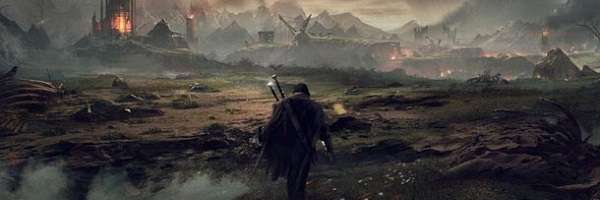
Middle-earth: Shadow of Mordor PS4 Review
Within the first 30 minutes of playing Shadow of Mordor, its core DNA is clearly apparent. This is a game that doesn’t hide its roots; it’s not embarrassed about where it has borrowed mechanics from other games that have inspired it. This is a game set in the world of Tolkien’s Middle-earth, but this isn’t a straight-forward Middle-earth title that you have seen in Lego form or back in the early-to-middle 2000s where EA was releasing hack and slash titles featuring the characters from The Lord of the Rings films. Instead, this is a game that takes Assassin’s Creed open world climbing shenanigans and blends it with the Batman: Arkham combat system, while adding its own cool attacks and twist on enemy behaviour to offer a very exciting title that makes travelling Mordor one full of adrenaline fuelled mature fun, while making players feel like a one man badass.
An exciting premise is that Shadow of Mordor is an original story that fits between The Hobbit and The Lord of the Rings. There is a sense of importance behind what the developers, Monolith, were crafting with the story, as they worked with the parent company of Tolkien’s universe to discuss and develop a story that would fit in the universe without disrupting the canon. There are some liberties taken with certain well-known characters, but I wouldn’t say it’s enough to cause you to shout in anger about them being disrespectful to the literature.
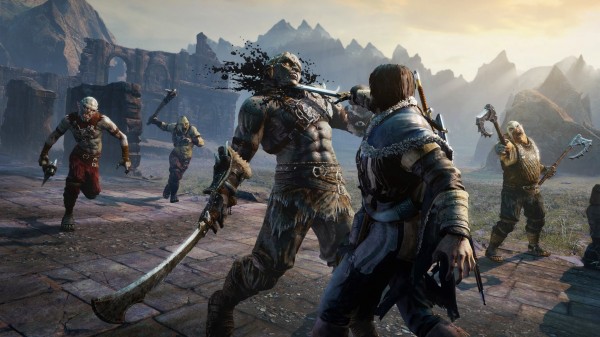
Players are thrown into the boots of Tailon, a ranger captain who has been stationed at the Black Gate. It’s only a few minutes into the opening that the station is attacked by a force of Uruk led by three highly powerful captains, who the leader is the Black Hand of Sauron. Things don’t end well and Talion finds himself slaughtered in a ritual to summon the Elf Lord Celebrimbor, only to have this wraith merge with his body, resurrecting himself with new found powers. Celebrimbor is suffering from a case of wraith amnesia, so willingly offers Tailon his powers to explore the depths of Mordor and figure out who Celebrimbor is and why he was bounded to Tailon.
The plot itself is rather simple and doesn’t go deep into supplying a crazy tale. This isn’t a game that you’ll remember for the story, but more for the activities in the quests and side missions that litter the land during the flat storytelling parts. It certainly starts with a bang, with action beginning as soon you press X to start the game. The game doesn’t waste spending time with tutorials – as this is one of the shortest tutorials I can remember in an action-based game – before you are on your way climbing walls and slaughtering orcs. Issues appear towards the end of the adventure. People might be a little disappointed in the conclusion towards a boss fight showdown that is much more scripted (and in turn disappointing) than the wonderful nature of the Nemesis system that players have dealt with up to that point in the game’s open world environment.
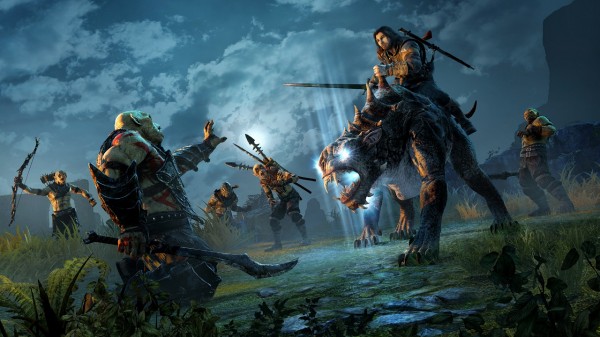
To me, it was clear that the Nemesis system is the star of the game and is a mechanic that is truly refreshing for the genre. Scattered around the open world are various Uruk grunts, captains and warchiefs, making up a hierarchy of strong warriors that lead the armies situated in the areas of Mordor. Each one of these key enemy leaders come with their own name, such as Rûg the Bone Collector, which is randomly picked from a huge collection of names. These also come with their own strengths and weaknesses, basically creating an unpredictable powered bad guy who could be immune to ranged attacks or stealth takedowns, or is scared of fire and weak to mounted beasts, letting Tailon instantly kill them with a Caragor.
The Nemesis system doesn’t simply stop at crafting unique names for the important enemies, but actually gives them personality. Many a times you will clash heads with enemies that will insult you, and if you manage to deal enough damage the enemy will become feared and try to escape from battle. If this happens, then they will remember how you treated them and will come back for revenge later on, often with some sort of buff to counter your attacks. Even if you manage to defeat them, they must be decapitated, or sometimes these dazed foes will eventually awaken and come back to you in battle covered with battle scars on their face or dangerously crafted prosthetic weapons replacing their lost limbs.

While all this action between Tailon and the enemy is going on, Orcs and Uruks will also challenge each other for promotion in ranks. This is seen on a special screen that displays all the current enemies that can be discovered in Mordor. Usually, the winner of the fight will gain more power, making them harder to take down and giving them a bigger army of throwaway orcs to surround them in battle. A lot of the nemesis enemies are shaded out and can’t be revealed unless you grab hold of a highlighted enemy that contains intelligence on their location. Doing this will clear the silhouette, revealing their location, strengths and weaknesses. Of course, you can also end up running into them in the midst of battle, but the big ones, the warchiefs, will often need scouting out from enemy intel before they truly show their face on the battlefield.
This is a game where the enemies should be forgettable, these are orcs and other such Tolkien fantasy monsters that you see in plenty of other fantasy settings, yet the dynamic AI personality adds charisma to them, giving them more attention than they would normally have received in such a game. It is its own breathing little town where transitions are happening all the time between the forever backstabbing race of Uruks and Orcs. It’s virtually impossible to kill them all, because any sort of time transition or death of your character will summon reinforcements to aid in the battle. This, however, does keep the encounters exciting throughout the game, especially when you’ve laid the smackdown on someone so much that they just flee from you on sight. It’s a delightful sense of empowerment over them and certainly adds to building up an ego.
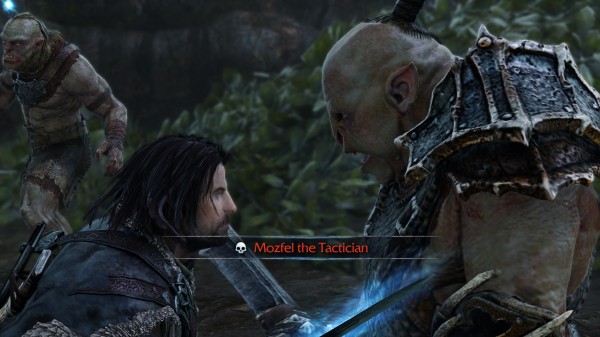
Moving away from the nemesis system and focusing on the rest of the gameplay, the action in Shadow of Mordor is very similar to the likes of recent Batman games, except Tailon doesn’t follow the rule of not killing anyone, so the death count clocks up tremendously. There is a lot of sneaking, with Tailon having the ability to climb up walls, a la Assassin’s Creed, while being able to crouch and move in a speedy silent manner to do instant death stealth kills on unsuspecting green dudes. Various tools are included to help you distract enemies, and having the powers of the embedded wraith means you can whisper in the ears of enemies and watch them coming walking to the area you are hiding – great for splitting groups and taking them down one at a time. I did find that often the enemies would notice the body, and not being able to move a dead body means you have to deal with the aftermath, which is usually a fight against a big group. It gets even worse in protected campsites, as I was at one point fighting off a pack of about 15 enemies and the outcome wasn’t pretty for me.
Combat is satisfying, and for anyone who has played any of the Caped Crusader’s games will be able to adapt to this with ease. There’s a heavy emphasis on countering, tapping triangle when shown above the assaulter to push them away. A nice feature is that the combat doesn’t feel like the enemy is waiting for someone to attack, you often find that two will come at once, and both can be counter by tapping the counter button twice. It’s not ground breaking, but it feels like a step in the right direction to remove the problem of AI looking aimlessly while one of their team mates are fighting. Timing attacks correctly will build a metre that eventually allows Tailon to do an execution move, or once unlocked, a move to hit the ground and push enemies away from you to give breathing space. Animations are stiff, and it can be a strange when you see Tailon suddenly travel in a quick and unrealistic movement to the next enemy to hit a sword strike. This is an issue that has plagued both Batman and the Assassin’s Creed series, and it’s in Shadow of Mordor in full force.
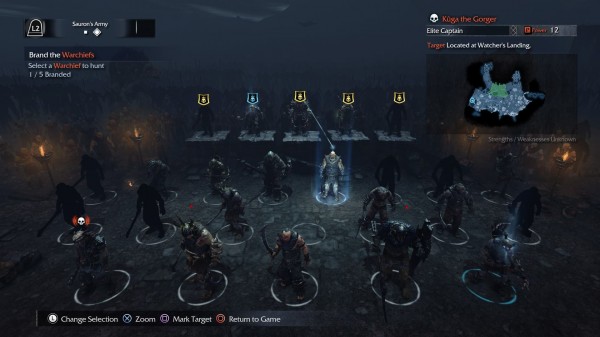
Fighting with a sword in close quarters isn’t the only option, as Tailon is rather good at using a bow that fires special arrows from the wraith world. On top of this, the addition of wraith powers allow Tailon to see enemies through walls, use the stun punch to get a free combo, sap energy from foes to replace wraith energy, gain more arrows or even force the enemy to turn sides and fight for you. It might be a familiar combat system, but there are things here that add to the counter-focused fighting that keep it engaging enough to not grow bored of it.
Interestingly, there is no equipment swapping. Tailon will continue to use the same sword, dagger and bow throughout the game, so to offer changes, the weapons can be fused with discovered runes to change its properties. Beating side missions offer power points that once hitting certain targets will unlock more skills. Towards the latter half of the game Tailon becomes ridiculously powerful, almost to the point where nothing can stop him – it really feels like you are playing some sort of ranger god of destruction. Up until that point though, the game can be challenging at times, especially if you aren’t very good at keeping stealthy. I also find the inclusion of the few missions that feature instant failures when you are discovered can cause some frustration, but generally, the missions are straight-forward and entertaining.

While Shadow of Mordor is an open world game, the size of land is on the smaller side – there is a second place, but again, its map is small – that means traversing across the map doesn’t take long, but the small area is compact with plenty of fighting to do or hidden treasures to discover. Enemies are everywhere, so you’re never out of a fight for too long. The theme of Mordor is one of dark colourings, often brown, which makes sense given the description of the location in the lore, but with so many games being in this colour pallet, it can be dreary having to experience it. This is also true with the enemies, while there are various designs of Orcs and Uruks, and other beasts, by the end of the game I was wishing for more creativity in design, as I was feeling tired of the same few enemy creations. It’s understandable that there is a limitation to this due to the licencing of the property.
Running at a lovely 1080p and what seems to be a solid 30fps means that the game does look great, especially when the rain lashes down, covering the canvas in a muddy coating. It also seems that the developers borrowed the Batman cape cloth tech, as Tailon’s clothes move rather swanky during movement.

While a lot of the mechanics are familiar, but covered in a hint of Tolkien’s universe, Middle-earth: Shadow of Mordor completely sneaked under my radar. Going into it with no expectations, I was pleasantly surprised with the outcome and quality of the game. The nemesis system is excellently crafted to give enemies much needed individuality that has never been seen in the genre before. The nemesis system is something I can totally see being used in other titles going forward – it adds a better sense of uniqueness to the battles and crafts a small story between you as a player and the enemy characters.
Simply put, Middle-earth: Shadow of Mordor is the best game based on The Lord of the Rings licence that brings solid combat, good sneaking mechanics and joyful side content, but above all, brings an innovating mechanic to the table that is so often hard to do in this current gaming climate. Fans and non-fans of The Lord of the Rings, especially the people who enjoy open world games – such as the two games that inspired Middle-earth: Shadow of Mordor – would be hobbit mad to miss this great action game.
